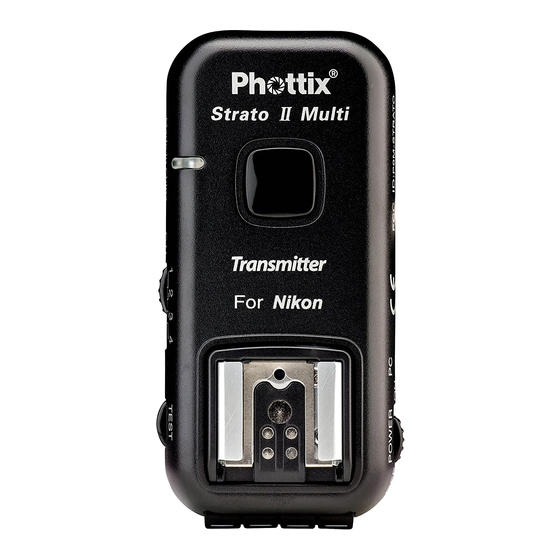Table of Contents
Advertisement
Quick Links
Advertisement
Table of Contents

Summary of Contents for Phottix Strato II Multi
- Page 1 Phottix Strato Multi Instructions PHOTTIX Strato Multi Transmitter Parts Transmitter 1) Power Switch 2) 3.5mm PC Input Port 3) Channel Selector Switch 4) Test Button 5) Group Selection Buttons 6) TTL Hot Shoe Port 7) Shutter Button, 8) Status LED...
- Page 2 4. Replace the battery cover and push back into the locked position. Turning transmitter on/off To turn on the Phottix Strato Multi transmitter or receiver– move the power switch to the “ON” position. 1. To turn off the Phottix Strato Multi transmitter move the power switch to the “OFF”...
- Page 3 1. Phottix Strato Multi System is compatible with the Phottix Strato 4-in-1 Wireless receivers. 2. Phottix Strato 4-in-1 receivers can be triggered on channels 1 to 4. They cannot be assigned groups and will fire if the Strato Multi transmitter is set to groups A, B, C or D.
- Page 4 4. Turn on the flash and the Phottix Strato Multi receiver. 5. Set the flash to Manual mode (receiver only). * It is not unusual for the flash to discharge once after turning on the Phottix Strato Multi. Using the Strato Multi as a wireless shutter release* Strato Multi Turn off the camera and the Phottix Strato Multi receiver.
- Page 5 Interference: The Phottix Strato Multi transmits and receives radio signals at 2.4 GHz. Its performance can be affected by electrical current, magnetic fields, radio signals, wireless routers, cellular phones, and other electronic devices. Environmental objects, such as large buildings or walls, trees, fences, or cars can also affect performance.
- Page 6 FCC ID: XBYFKT05ZI This device complies with Part 15 of the FCC Rules. Operation is subject to the following two conditions: (1) this device may not cause harmful interference, and (2) this device must accept any interference received, including interference that may cause undesired operation.



Need help?
Do you have a question about the Strato II Multi and is the answer not in the manual?
Questions and answers